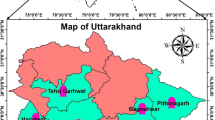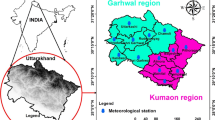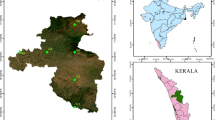Abstract
Drought, as a phenomenon that causes significant damage to agriculture and water resources, has increased across the globe due to climate change. Hence, scientists are attracted to developing drought prediction models for mitigation strategies. Different drought indices (DIs) have been proposed for drought monitoring during the past few decades, most of which are probabilistic, highly stochastic, and non-linear. The present study inspected the capability of various machine learning (ML) models, including artificial neural network (ANN) and support vector regression (SVR) as original predictive models and optimized by two selected algorithms, namely, particle swarm optimization (SVR-PSO) and response surface method (SVR-RSM) to predict the meteorological drought indices of standardized precipitation index (SPI), percentage of normal precipitation (PN), effective drought index (EDI), and modified China-Z index (MCZI) on a monthly time scale. A novel model named SVR-RMS is introduced by using two calibrating processes given from RSM with two inputs and the SVR by predicted data handled with RSM given from the first calibrating procedure. For evaluating the models, different meteorological input variables in the period 1981–2020 were considered from 11 synoptic stations in arid and semi-arid climates of Iran, which frequently experience droughts. The SPI showed the highest and lowest correlation with MCZI (0.71) and EDI (0.34), respectively. The results of testing dataset (2011–2020) indicated that the SVR-RSM produced superior abilities for both accuracy and tendency compared to other models, while the SVR-PSO model is better than the ANN and SVR. The worst results of drought prediction were obtained for EDI. However, all models provided the acceptable EDI prediction in the high-temperature station of Ahvaz in the south of the country. Application of SVR-RSM as a novel hybrid model can be suggested for predicting the DIs on a short time scale in arid and semi-arid areas.










Similar content being viewed by others
Availability of Data and Materials
Some data are available from the corresponding author upon requests.
References
Adamowski J, Chan HF (2011) A wavelet neural network conjunction model for groundwater level forecasting. J Hydrol 407(1–4):28–40
Adisa OM, Masinde M, Botai JO (2021) Assessment of the dissimilarities of EDI and SPI measures for drought determination in South Africa. Water 13(1):82
Ahmed K, Shahid S, Chung E-S, Wang X-j, Harun SB (2019) Climate change uncertainties in seasonal drought severity-area-frequency curves: Case of arid region of Pakistan. J Hydrol 570:473–485
Alamgir M, Shahid S, Hazarika MK, Nashrrullah S, Harun SB, Shamsudin S (2015) Analysis of meteorological drought pattern during different climatic and cropping seasons in Bangladesh. JAWRA J Am Water Resour Assoc 51(3):794–806
Ali M, Deo RC, Downs NJ, Maraseni T (2018) An ensemble-ANFIS based uncertainty assessment model for forecasting multi-scalar standardized precipitation index. Atmos Res 207:155–180
Baptista FD, Rodrigues S, Morgado-Dias F (2013) Performance comparison of ANN training algorithms for classification. In IEEE 8th International Symposium on Intelligent Signal Processing. Funchal, Portugal, pp 115–120
Belayneh A, Adamowski J, Khalil B (2016) Short-term SPI drought forecasting in the Awash River Basin in Ethiopia using wavelet transforms and machine learning methods. Sustain Water Resour Manag 2(1):87–101
Belayneh A, Adamowski J, Khalil B, Ozga-Zielinski B (2014) Long-term SPI drought forecasting in the Awash River Basin in Ethiopia using wavelet neural network and wavelet support vector regression models. J Hydrol 508:418–429
Belayneh A, Adamowski J, Khalil B, Quilty J (2016b) Coupling machine learning methods with wavelet transforms and the bootstrap and boosting ensemble approaches for drought prediction. Atmos Res 172:37–47
Boustani A, Ulke A (2020) Investigation of meteorological drought indices for environmental assessment of Yesilirmak Region. J Environ Treat Tech 8(1):374–381
Byun H-R, Wilhite DA (1999) Objective quantification of drought severity and duration. J Clim 12(9):2747–2756
Chen Y, Song L, Liu Y, Yang L, Li D (2020) A review of the artificial neural network models for water quality prediction. Appl Sci 10(17):5776
Chevalier RF, Hoogenboom G, McClendon RW, Paz JA (2011) Support vector regression with reduced training sets for air temperature prediction: a comparison with artificial neural networks. Neural Comput Appl 20(1):151–159
Dai A (2011) Drought under global warming: a review. Wiley Interdiscip Rev Clim Change 2(1):45–65
Das P, Naganna SR, Deka PC, Pushparaj J (2020) Hybrid wavelet packet machine learning approaches for drought modeling. Environ Earth Sci 79(10):1–18
Dastorani MT, Afkhami H (2011) Application of artificial neural networks on drought prediction in Yazd (Central Iran). Desert, 16(1):39–48
Dayal KS, Deo RC, Apan AA (2016) Application of hybrid artificial neural network algorithm for the prediction of standardized precipitation index. In IEEE Region 10 Conference (TENCON). Singapore, pp 2962–2966
Deng W, Yao R, Zhao H, Yang X, Li G (2019) A novel intelligent diagnosis method using optimal LS-SVM with improved PSO algorithm. Soft Comput 23(7):2445–2462
Deo RC, Kisi O, Singh VP (2017) Drought forecasting in eastern Australia using multivariate adaptive regression spline, least square support vector machine and M5Tree model. Atmos Res 184:149–175
Deo RC, Şahin M (2015a) Application of the artificial neural network model for prediction of monthly standardized precipitation and evapotranspiration index using hydrometeorological parameters and climate indices in eastern Australia. Atmos Res 161:65–81
Deo RC, Şahin M (2015b) Application of the extreme learning machine algorithm for the prediction of monthly Effective Drought Index in eastern Australia. Atmos Res 153:512–525
Dikshit A, Pradhan B, Alamri AM (2020) Temporal hydrological drought index forecasting for New South Wales. Australia Using Machine Learning Approaches Atmosphere 11(6):585
Edwards DC, McKee TB (1997) Characteristics of 20th century drought in the United States at multiple time scales. Atmospheric Science Paper 63:1–30
Eslamian S, Ostad-Ali-Askari K, Singh VP, Dalezios NR, Ghane M, Yihdego Y, Matouq M (2017) A review of drought indices. Int J Constr Res Civ Eng 3:48–66
Fung K, Huang Y, Koo C, Soh Y (2020) Drought forecasting: A review of modelling approaches 2007–2017. J Water Clim Change 11(3):771–799
Gunn SR (1998) Support vector machines for classification and regression. ISIS Technical Report 14(1):5–16
Harmel RD, Smith PK (2007) Consideration of measurement uncertainty in the evaluation of goodness-of-fit in hydrologic and water quality modeling. J Hydrol 337(3–4):326–336
Jain SK, Sudheer K (2008) Fitting of hydrologic models: a close look at the Nash-Sutcliffe index. J Hydrol Eng 13(10):981–986
Jain VK, Pandey RP, Jain MK, Byun H-R (2015) Comparison of drought indices for appraisal of drought characteristics in the Ken River Basin. Weather Clim Extremes 8:1–11
Kendall MG, Stuart A (1977) The advanced theory of statistics. Vol. 1: Distribution theory. Griffin, London
Kennedy J, Eberhart R (1995) Particle swarm optimization. In Proceedings of IEEE International Conference on Neural Networks, Perth, Australia, pp 1942–1948
Keshtegar B, Nehdi ML, Trung N-T, Kolahchi R (2021) Predicting load capacity of shear walls using SVR–RSM model. Appl Soft Comput 112:107739
Keshtegar B, Piri J, Kisi O (2016) A nonlinear mathematical modeling of daily pan evaporation based on conjugate gradient method. Comput Electron Agric 127:120–130
Keshtegar B, Yaseen ZM (2022) Reinforcing bar development length modeling using integrative support vector regression model with response surface method: New approach. ISA Transactions 128:423–434
Keyantash J, Dracup JA (2002) The quantification of drought: an evaluation of drought indices. Bull Am Meteor Soc 83(8):1167–1180
Khan GM (2018) Artificial neural network (ANNs). In Evolution of artificial neural development. Springer, Cham, pp 39–55
Khan N, Sachindra D, Shahid S, Ahmed K, Shiru MS, Nawaz N (2020) Prediction of droughts over Pakistan using machine learning algorithms. Adv Water Resour 139:103562
Kim T-W, Valdés JB (2003) Nonlinear model for drought forecasting based on a conjunction of wavelet transforms and neural networks. J Hydrol Eng 8(6):319–328
Kisi O, Cimen M (2011) A wavelet-support vector machine conjunction model for monthly streamflow forecasting. J Hydrol 399(1–2):132–140
Lima AR, Cannon AJ, Hsieh WW (2013) Nonlinear regression in environmental sciences by support vector machines combined with evolutionary strategy. Comput Geosci 50:136–144
Mahmoudi P, Rigi A, Kamak MM (2019) Evaluating the sensitivity of precipitation-based drought indices to different lengths of record. J Hydrol 579:124181
Malik A, Kumar A, Salih SQ, Kim S, Kim NW, Yaseen ZM, Singh VP (2020a) Drought index prediction using advanced fuzzy logic model: Regional case study over Kumaon in India. PLoS ONE 15(5):e0233280
Malik A, Tikhamarine Y, Souag-Gamane D, Kisi O, Pham QB (2020b) Support vector regression optimized by meta-heuristic algorithms for daily streamflow prediction. Stoch Env Res Risk Assess 34(11):1755–1773
Mashari Eshghabad S, Omidvar E, Solaimani K (2014) Efficiency of some meteorological drought indices in different time scales (case study: Tajan Basin, Iran). Ecopersia 2(1):441–453
McKee TB, Doesken NJ, Kleist J (1993) The relationship of drought frequency and duration to time scales. In Proceedings of the 8th Conference on Applied Climatology. Anaheim, United States, 17(22): 179–183
Mirjalili S, Song Dong J, Lewis A, Sadiq AS (2020) Particle swarm optimization: theory, literature review, and application in airfoil design. In: Mirjalili S, Song Dong J, Lewis A (eds) Nature-inspired optimizers, Springer, Cham, pp 167–184
Moriasi DN, Arnold JG, Van Liew MW, Bingner RL, Harmel RD, Veith TL (2007) Model evaluation guidelines for systematic quantification of accuracy in watershed simulations. Trans ASABE 50(3):885–900
Morid S, Smakhtin V, Moghaddasi M (2006) Comparison of seven meteorological indices for drought monitoring in Iran. Int J Climatol J R Meteorol Soc 26(7):971–985
Nabipour N, Dehghani M, Mosavi A, Shamshirband S (2020) Short-term hydrological drought forecasting based on different nature-inspired optimization algorithms hybridized with artificial neural networks. IEEE Access 8:15210–15222
Naderianfar M, Piri J, Kisi O (2017) Pre-processing data to predict groundwater levels using the fuzzy standardized evapotranspiration and precipitation index (SEPI). Water Resour Manag 31(14):4433–4448
Nash JE, Sutcliffe JV (1970) River flow forecasting through conceptual models part I—A discussion of principles. J Hydrol 10(3):282–290
Nguyen-Huy T, Deo RC, Yaseen ZM, Prasad R, Mushtaq S (2021) Bayesian Markov chain Monte Carlo-based copulas: factoring the role of large-scale climate indices in monthly flood prediction. In Intelligent data analytics for decision-support systems in hazard mitigation. Springer, Singapore, pp 29–47
Özkaya SG, Durur H, Baygin M, Kazaz İ (2021) Artificial neural network and image processing based compressive strength prediction. Erzincan Univ J Sci Technol 14(2):408–421
Panahi M, Sadhasivam N, Pourghasemi HR, Rezaie F, Lee S (2020) Spatial prediction of groundwater potential mapping based on convolutional neural network (CNN) and support vector regression (SVR). J Hydrol 588:125033
Park S, Im J, Jang E, Rhee J (2016) Drought assessment and monitoring through blending of multi-sensor indices using machine learning approaches for different climate regions. AgrForest Meteorol 216:157–169
Sivanandam M, Paulraj S (2009) Introduction to artificial neural networks. Vikas Publishing House, New Delhi
Pérez-Alarcón A, Garcia-Cortes D, Fernández-Alvarez JC, Martínez-González Y (2022) Improving monthly rainfall forecast in a watershed by combining neural networks and autoregressive models. Environ Process 9(3):1–26
Pham QB, Abba SI, Usman AG, Linh NTT, Gupta V, Malik A, Costache R, Vo ND, Tri DQ (2019) Potential of hybrid data-intelligence algorithms for multi-station modelling of rainfall. Water Resour Manag 33(15):5067–5087
Piri J, Amin S, Moghaddamnia A, Keshavarz A, Han D, Remesan R (2009) Daily pan evaporation modeling in a hot and dry climate. J Hydrol Eng 14(8):803–811
Rhee J, Im J (2017) Meteorological drought forecasting for ungauged areas based on machine learning: Using long-range climate forecast and remote sensing data. AgrForest Meteorol 237:105–122
Shahabfar A, Eitzinger J (2013) Spatio-temporal analysis of droughts in semi-arid regions by using meteorological drought indices. Atmosphere 4(2):94–112
Singh J, Knapp HV, Arnold J, Demissie M (2005) Hydrological modeling of the Iroquois river watershed using HSPF and SWAT 1. JAWRA J Am Water Resour Assoc 41(2):343–360
Sridhara S, Chaithra G, Gopakkali P (2021) Assessment and monitoring of drought in Chitradurga district of Karnataka using different drought indices. J Agrometeorol 23(2):221–227
Vapnik V (1995) The nature of statistical learning theory. Springer, New York, USA
Wable PS, Jha MK, Shekhar A (2019) Comparison of drought indices in a semi-arid river basin of India. Water Resour Manag 33(1):75–102
Wilhite DA, Glantz MH (1985) Understanding: the drought phenomenon: the role of definitions. Water Int 10(3):111–120
Willmott CJ (1981) On the validation of models. Phys Geogr 2(2):184–194
Wu H, Hayes MJ, Weiss A, Hu Q (2001) An evaluation of the standardized precipitation index, the China-Z Index and the statistical Z-Score. Int J Climatol J R Meteorol Soc 21(6):745–758
Yaseen ZM, Ali M, Sharafati A, Al-Ansari N, Shahid S (2021) Forecasting standardized precipitation index using data intelligence models: regional investigation of Bangladesh. Sci Rep 11(1):1–25
Zhong X, Dutta U (2015) Engaging Nash-Sutcliffe efficiency and model efficiency factor indicators in selecting and validating effective light rail system operation and maintenance cost models. J Traffic Transp Eng 3:255–265
Author information
Authors and Affiliations
Contributions
B. Keshtegar designed and developed the theoretical formulations. Data collection and analysis were performed by M. Abdolahipour. The computations and modeling were done by J. Piri. The first draft of the manuscript was written by M. Abdolahipour and all authors commented on previous versions of the manuscript. All authors read and approved the final manuscript.
Corresponding author
Ethics declarations
Ethical Approval
Not applicable.
Consent to Participate
Not applicable.
Consent to Publish
The authors agree to publish in the journal.
Competing Interests
The Authors declare no conflict of interests.
Additional information
Publisher's Note
Springer Nature remains neutral with regard to jurisdictional claims in published maps and institutional affiliations.
Highlights
• Using different meteorological input variables, the capability of four machine learning models was evaluated for prediction of short-term drought indices.
• A novel hybrid model is proposed for prediction of drought indices.
• The SVR-RSM showed superior performance in prediction of monthly drought indices.
• For arid and semi-arid areas, the hybrid SVR models showed more accurate results.
•A higher correlation between meteorological drought indices was observed in drier conditions.
Appendix
Appendix
Rights and permissions
Springer Nature or its licensor (e.g. a society or other partner) holds exclusive rights to this article under a publishing agreement with the author(s) or other rightsholder(s); author self-archiving of the accepted manuscript version of this article is solely governed by the terms of such publishing agreement and applicable law.
About this article
Cite this article
Piri, J., Abdolahipour, M. & Keshtegar, B. Advanced Machine Learning Model for Prediction of Drought Indices using Hybrid SVR-RSM. Water Resour Manage 37, 683–712 (2023). https://doi.org/10.1007/s11269-022-03395-8
Received:
Accepted:
Published:
Issue Date:
DOI: https://doi.org/10.1007/s11269-022-03395-8




